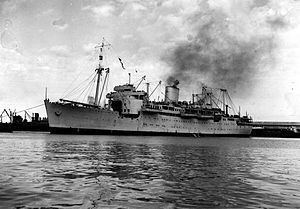Decommissioned 25 March 1949 Construction started July 1933 Length 143 m Draft 7.44 m | Laid down July 1933 Weight 11,160 tons Launched 15 December 1935 Displacement 9.965 million kg Builder Harland and Wolff | |
 | ||
Renamed Kanimbla (1936–1939)HMS Kanimbla (1939–1943)HMAS Kanimbla (1943–1950)Oriental Queen (1961 onwards) | ||
HMAS Kanimbla was a passenger ship converted for use as an armed merchant cruiser and landing ship infantry during World War II. Built during the mid-1930s as the passenger liner MV Kanimbla for McIlwraith McEachern Limited, the ship operated in Australian waters until 1939, when she was requisitioned for military service, converted into an armed merchant cruiser, and commissioned in the Royal Navy as HMS Kanimbla.
Contents
Initially used to board and take control of merchant vessels belonging to Occupied Europe and operating in Asian waters, Kanimbla led the raid to capture the Iranian port of Bandar Shahpur in August 1941, and was present during the Japanese submarine attack on Sydney Harbour in 1942. In 1943, the ship was converted into a Landing Ship Infantry, transferred to the Royal Australian Navy, and operated throughout the South West Pacific Theatre until the end of the war.
Kanimbla was decommissioned and returned to her commercial owners in 1950. In 1961, she was sold to the Pacific Transport Company and renamed Oriental Queen. The ship operated as a liner throughout the Pacific and to Japan until 1973, when she was broken up for scrap.
Construction
The ship was laid down as motor vessel (MV) Kanimbla for McIlwraith McEachern Limited by Harland and Wolff Limited at Belfast in Northern Ireland. She was launched on 15 December 1935 and completed in 1936.
The ship was named for the Kanimbla Valley, west of Blackheath in the Blue Mountains in New South Wales.
Pre-war
The ship operated a passenger service between Cairns, Queensland and Fremantle, Western Australia until the outbreak of World War II.
World War II
Om 5 September 1939, Kanimbla was requisitioned for military service, and underwent conversion to an armed merchant cruiser at Garden Island, in Sydney. She was commissioned into the Royal Navy as HMS Kanimbla, though with a largely Australian crew, on 6 September 1939. The ship was assigned the pennant number F23.
Kanimbla was engaged in patrolling the coasts of Asia and boarding vessels of German or occupied Europe origin.
On 24 August 1941, Kanimbla led a raid to capture the Iranian port of Bandar Shahpur. The ship led seven other vessels, including the gunboat HMS Cockchafer, the corvette HMS Snapdragon, the naval trawler HMT Arthur Cavannagh, the sloop HMIS Lawrence, an oil rig tugboat, and a dhow. In addition, Kanimbla carried 300 Indian troops, including Gurkhas and soldiers from 3rd Battalion, 10th Baluch Regiment, whose task was to board and capture the German cargo ship Hohenfels. Kanimbla used her armament in support of the raid, which resulted in the securing of the railhead, and the capture of eight Axis merchantmen, two gunboats, and a floating dock were captured as well as the railhead.
Kanimbla was one of several Allied vessels located in Sydney Harbour during the attack by Japanese midget submarines on 31 May 1942.
She arrived back in Sydney on 2 April 1943, was converted to a Landing Ship Infantry (LSI) and commissioned into the Royal Australian Navy as HMAS Kanimbla on 1 June 1943. She received the pennant number C78. In this configuration, she could carry 1,280 troops, and carried up to 22 LCVPs, plus two Landing Craft Mechanised.
The ship earned five battle honours for her wartime service: "New Guinea 1944", "Leyte Gulf 1944", "Lingayen Gulf 1945", "Borneo 1945", and "Pacific 1945".
Post-war
Kanimbla paid off at Sydney on 25 March 1949 and was returned to her owners on 13 December 1950. In 1961, the ship was sold to the Pacific Transport Company and renamed Oriental Queen. For the next three years, the ship was chartered to transport pilgrims between Indonesia and Jeddah. In 1964, Oriental Queen was chartered by a Japanese shipping company and served as a liner on the Yokohama – Guam route. The vessel was later sold outright to the Japanese charterer. Oriental Queen's career ended in 1973, with the ship's sale to Taiwanese breakers for scrapping.
